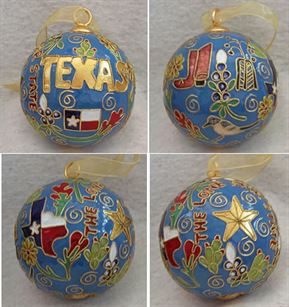We worked with renowned Texas artist, Kitty Keller and her daughter, Maggie, on designing this exclusive cloisonne ornament just for us...you won't find this ornament anywhere else but here on the Texas Trading Post.
The art of cloisonne is a centuries old process, and one that Kitty specializes in. As we were designing this ornament, we wanted one that was "pure Texas" and one that captured the true spirit of Texas! ...and so it was done...
We tried to capture Texas on all four sides of the ornament. On one side is the Texas State map with oak leaves...moving around is "The Lone Star State" and the Texas Lone Star. As your eyes move to the next side, there is "TEXAS" in gold letters with the Texas State Flag underneath and lastly, cowboy boots, an oil derrick, a Mockingbird and the Texas Bluebonnet round off the ornament. The blue background is reminiscent of our Texas skies. This is, quite simply....Pure Texas!
Designed by renowned Texas artist, Kitty Keller, the centuries old process of making her cloisonne ornaments by hand are created by her artisans in China - one of the few places left in the world where craftsmen know how to make this absolutely gorgeous ornament, something that will be treasured for a lifetime.
The step-by-step process in creating a cloisonne ornament:
1. A hollow copper ball is formed.
2. A design is drawn onto the copper ball using a pencil. Artisans then begin attaching copper filaments to the ornament. These filaments create small compartments of “cloisons.”
3. The cloisons are then filled with enamel pastes using miniature spatulas, a different one for each color. As the pastes do not resemble the actual colors of the enamel after firing this process is tedious and requires the artisan to clearly visualize the look of the finished ornament.
4. When the paste has dried the ornament is then put into a kiln and fired for a few minutes. The dried paste then melts and solidifies. Because the enamels shrink with firing, repeated applications and firings are necessary to fill the cells to overflowing.
5. When the enameling is complete, artisans rub the uneven surface until it is smooth and flush with the edges of the cloisons.
6. Finally, the ornament is polished and the exposed edges of the metal wires and top and bottom of the ornament are electroplated with gold.






